June 8, 2017
An interlude

This week’s radio silence brought to you by fun nights out, lots of busyness, and a string of books that just aren’t taking. As ever, I’ve been instagramming though, so head over there to see what you’re missing—which is mostly hammocks.
June 4, 2017
Iris is Four

The most remarkable thing about Iris turning four (tomorrow!) is that she will be the same age that Harriet was when Iris was born. A crazy milestone, first that we’ve never had a four-year-old without a newborn, so this is a new kind of unencumbrance. And also how strange it is that we thought Harriet was so old at the age of four, whereas Iris will forever be the baby, never mind all the incredible things she does—writing her letters, knowing her numbers, drawing pictures, making up songs, and all kinds of other things her sister didn’t do at the same age. When Harriet went to kindergarten, I recall being mildly troubled because she never drew, never mind all the crayons and paper we had around the house, and how she was only interesting in using her scissors to cut the paper into little tiny pieces, and I wondered if she was drawing delayed…all of which is to say that I have always been a bit neurotic. But still, Iris will head off to kindergarten with all kinds of skills already and she’s going to learn more. We’re currently reading Ramona The Pest in order to get kindergarten-going top-of-mind and she keeps waiting for the moment when she’ll finally learn to read and write, and I’ve got a feeling that for Iris it’s not so long in coming.
These little check-ins with the people my children are are more precious than I ever realize when I write them, which I only ever realize when I go back and read them, like this one from last March. Harriet is fairly familiar, but Iris has been eleveneen people since then. And so it’s useful to sit down and note the particulars of this moment, of Iris at four. Iris, who gets a bad rap as our family mischief maker (and I have a distinct memory of cleaning crayon off the wall this morning) but who might deserve more credit than we give her—her teacher has wonderful things to say about her as a student, a leader, and a friend. She is well-liked by her classmates and they fight over who gets to sit next to her at snack time, which is good because at our house that’s kind of the booby prize. But see, I’m doing it again. Iris is notorious. She has the most curious facial expressions, and verbal expressions. She is the opposite of sugar and spice and all things nice, although she can be really nice. She gives incredible hugs and is not so big that she doesn’t like sitting on people. At Harriet’s swim class she sits on my lap and I hold her, smelling her hair, reading a magazine together, and I’m thinking it’s not going to be much longer before I never hold anybody like this again.

She loves pink and purple, and Taylor Swift. She likes to dance and do whatever her sister is doing, although she always wants to play the game longer than anyone else does. She sleeps in her own bed now, in the room she shares with her sister and on the best mornings we come downstairs and hear them in there talking together. She talks about poo all the time, so much so that it’s not remotely funny, but she’s amusing herself. She likes hotdogs, but not the bun, and spaghetti, but not the sauce, and pizza, but only disassembled, plain dough and a pile of grated cheese. She can make games out of anything—a pile of pebbles, some pencils, Thomas the Tank Engine Trains and the game is always that one is the daddy, the other is the mommy, and the third pebble/pencil/tank engine is the baby. She can sing the alphabet, but only up to TUV and then she skips the rest. Recently she’s been telling us all over and again how boy tigers have hair and girl tigers have no hair, we don’t feel the need to correct her, re. manes and lions. She likes to make presents for Harriet. She’s partial to walking around the house muttering “for god’s sake,” apropos of nothing. She likes to help with baking, and she really is helpful. She climbs up on everything, and it’s kind of terrifying, so we close our eyes and/or look the other way. She’s the most physically coordinated member of our family, although that’s not saying much. But still. We love her. She’s awesome. Our funny looking baby who spent her early days resembling a dinosaur, and now she’s living proof that all of us and she herself have come a long long way.
June 2, 2017
Up, by Susan Hughes and Ashley Barron

I don’t know where spring went. It was March and then ten minutes later it was June, which means we’ve just a few weeks left of playschool. Playschool, which has been so important to our family since Harriet began in 2012. Playschool, which has begotten us crafts and friends and songs and dances, and books, and where we’ve all learned so much, because being part of a co-op brings lessons for everyone. Very good lessons, about working with other people, and learning from their strengths, and what all of us can learn from each other.

When I bought the book Up: How Families Around the World Carry Their Little Ones, by Susan Hughes and Ashley Barron, I had it in my mind as a gift for playschool. Not just because the idea of carrying babies and playschool going hand-in-hand for me, as Iris spent much of her first year of life on my front or back in her carrier on my co-op shifts. (I used to beg the children not to bang their tin plates on the table, because it always made her wake up early.)

But also because playschool is all about babies, or at least no one loves babies more than the kids there do. They love books about babies, and pictures of babies, and playing with dolls that are babies, and little brother and sister babies. They push babies in strollers and plastic shopping cards, and shoved inside their shirts with babies’ heads poking out, a DIY Baby Bjorn kind of deal.

I also knew that with its inclusivity of characters from different races, who live in different countries and come from different cultures all over the year, and its representation of diverse families and physical ability that this was a book that playschool would be able to get behind. Government policy dictates that inclusive toys and images featuring racial diversity and disabled people must be present in all play areas of the classroom. On one hand, that’s “political correctness gone mad” [and kind of tricky for a non-profit to fund] but three seconds later I realize the implications of young children growing up with images omnipresent, diversity being just normal for them. Because it actually is.

Finally, Up is a playschool book, because playschool is all about stories. These kids know books. In all my years of co-opping, I’ve never once sat down to read a picture book and not found myself surrounded by children wanting to hear the story (including the ones fighting to sit on my lap). These kids have an ever-changing range of books to choose from on their story shelf (from a huge and incredible library in the back room that stretches back decades. Some books never go out of style). They get trips to the library, and stories every day, and at free time many of them elect to pick up a book and sit down with it.
And so we’ll leave a note on the inside cover of this story, thanking playschool for so many extraordinary years (and days!) and letting them know that this is a gift from us. It’s nice to think of the children in the years ahead who’ll be enjoying this book while my own are out exploring the wider horizons playschool has set them on a path toward.
June 1, 2017
Little Sister, by Barbara Gowdy
 Has extreme weather always been a feature of literature? Certainly the flood in The Mill on the Floss wasn’t caused by climate change. But it seems particularly meaningful in a troubling fashion to be encountering so much bad weather in books lately—floods in new books by Carleigh Baker, Margaret Drabble and Leanna Betamasosake Simpson as floods have closed Toronto Island. Yesterday and the day before as the weather moved between sunshine and thunderclaps every ten minutes or so kept calling to mind Barbara Gowdy’s new novel, Little Sister, which I read last week. There is something disconcerting about the unsettled weather I keep finding in books these days, almost more so than the unsettled weather in the actual world. The way it narrows the space between truth and fiction, eerily seeming to make all things possible.
Has extreme weather always been a feature of literature? Certainly the flood in The Mill on the Floss wasn’t caused by climate change. But it seems particularly meaningful in a troubling fashion to be encountering so much bad weather in books lately—floods in new books by Carleigh Baker, Margaret Drabble and Leanna Betamasosake Simpson as floods have closed Toronto Island. Yesterday and the day before as the weather moved between sunshine and thunderclaps every ten minutes or so kept calling to mind Barbara Gowdy’s new novel, Little Sister, which I read last week. There is something disconcerting about the unsettled weather I keep finding in books these days, almost more so than the unsettled weather in the actual world. The way it narrows the space between truth and fiction, eerily seeming to make all things possible.
Although there is something disconcerting about the work of Barbara Gowdy in general, Gowdy who is best known for her short story collection which includes a tale of necrophilia. The idea of Barbara Gowdy’s work is more pressing in my mind than the work itself—I read her novel, Fallen Angels, years ago, and then completely forgot about having done so. The book about the elephants, which I never even read. My salient memory of We So Seldom Look on Love is a story about a child who is decapitated while being carried on an adult’s shoulders, a tragic encounter with a ceiling fan—Harriet overheard me explaining this synopsis when she was three, and then became obsessed with it, which lead to this very macabre post about gingerbread men. I wonder if the idea of reading Barbara Gowdy might be bigger than the work itself, possibly because the experience is so visceral.
There was a point in Little Sister where I became incapable of putting the book down, not because I was “gripped” necessarily (although I was enjoying the book entirely) but instead because never in my entire life had I had any less idea about where a novel was going to go. I stayed up that night reading well past midnight because I had to find out and couldn’t rest until I did. The answer is not obvious, um, obviously. This is the story of a woman who runs a repertory cinema with her mother who is suffering from dementia, and who keeps slipping in and out of another woman’s body during thunderstorms. Not occupying the other woman’s consciousness, but being privy to it, and she spots the other woman’s eyes in the mirror, eyes that seem to belong to her sister who died under circumstances the reader doesn’t learn until later.
It’s all so ordinary, that’s the thing. Plausible, even, because all the details are concrete, the geography mapping properly onto reality as I know it. (Quite literally: like much of Gowdy’s work, this is a story set in Toronto.) It reminded me of Aimee Bender’s The Particular Sadness of the Lemon Cake, which I read a few years ago. Both books with such understated sorrow, and protagonists named Rose also. Magic realism, but without the magic. Or maybe the point is that the magic is so real, of this world entirely?
I loved Little Sister. Rose becomes obsessed with locating the woman whose body she keeps possessing, craving thunder (which she has the inside track on—her boyfriend is a meteorologist). So much goes unspoken, and the whole novel is about the spaces between us, the desperation for connection, the gap between a first person narrator and third, how we see ourselves and the ways we are seen. All of it very understated, the opposite of cinematic, but it riffs on cinema too because of the setting, all things being connected, the question for reader being: how?
And here is where the magic is. And maybe also it’s the question that is the very point.
May 30, 2017
Big As Life
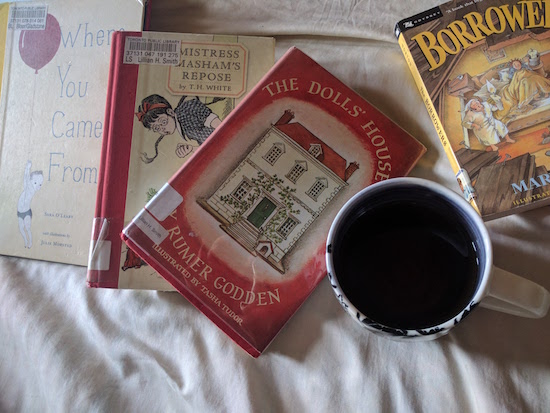
I fell in love with Sara O’Leary’s picture books back when I wasn’t even into picture books, before I had children. I discovered her via the blog Crooked House, when Stephany Aulenback published an interview with her in 2007. (Stephany Aulenback delivered me to all the best things, and I miss her blog: she is also the reason I read Harriet the Spy.) I loved O’Leary’s first picture book, When You Were Small, and it’s where my love of Julie Morstad’s work began—we’ve now got a print of hers hanging in our hallway. All of which is to say that Sara O’Leary’s work has been a part of my life in an essential way for a long time now.
And so I was particularly delighted by the opportunity to write about her books for The Walrus, an adventure that had me revisiting microscopic books at Toronto Public Library’s Osborne Collection and calling them up to clarify just how many miniature books they had—amusingly, all online references noted the collection of miniatures was “sizeable.” I got to revisit The Borrowers, and read Rumer Godden’s The Dolls’ House and T.H. White’s Mistress Mashem’s Repose. I was also recommended Jerry Griswold’s fascinating book, Feeling Like a Kid: Childhood and Children’s Literature—the chapter on “snugness” was my favourite.
So much stuff I came up with didn’t make it into the final piece (1800 words is not so long…) but it was all so fascinating. Everyone was sick in my house on Christmas Eve, which was annoying but left me free to read the entirety of O’Leary’s collection of short stories for adults, Comfort Me With Apples. (Note: she also has a novel for grown up children forthcoming next year, a ghost story which, unsurprisingly, features a dollhouse…) I was particularly struck by O’Leary’s preoccupation in these stories with so many of the ideas that would surface in her work for children a decade or more later—children with indeterminable origins, the fundamental unknowability of mothers, families that weren’t the way they were supposed to be, subtle allusions to nursery rhymes, and particularly ideas about size and scale.
I found O’Leary’s novella in the collection, “Big As Life,” made for the most fascinating companion to her Henry books. It begins with a woman sharing her first childhood memory, which her mother informs her is not a true memory but more likely something she dreamed once. This mother too who wishes to foster a more equal relationship with her daughter, to be like roommates who where the same clothes, which reminds me of the mother in When I Was Small who tells stories so she and her son “can be small together.” Lost photographs, so the woman is unable to corroborate anything she remembers from when she was small. The mother talking about her pregnancy, explaining, “Even though I was getting bigger all the time it felt like I was disappearing.”
This one extraordinary part where the women recalls the stories she used to tell her baby brother about when he was small: “I tried to tell him about who we were, what we’d been doing before he came along…I never prayed when I was a child, but somehow, telling my baby brother all I knew about life so far, I came close.”
And then this one incredible paragraph, from the perspective of a child watching her mother:
“The expression on her face—it was like she was aloft in a hot air balloon and we were all rapidly diminishing to the size and importance of ants on the ground below. It was as though soon we would grow too small to be seen, disappear, never to have existed at all. This, at least, is what I imagine, years later, trying to remember why I had grown suddenly enraged at the sight of my mother reading a book and smoking a cigarette.”
I am not sure at the connections one could make between the two works, what they mean. From reading the picture books we know that ants are actually pretty important after all and there is reverence for smallness—but perhaps you have to grow up in order to fully understand this. I think you also have to be grown-up to appreciate a mother’s desire to sometimes float away.
Parent/child relationships are complicated and fraught, it is true, but as I write in my Walrus piece, O’Leary’s picture books offer the suggestion of connection—just one of the many possibilities of small things.
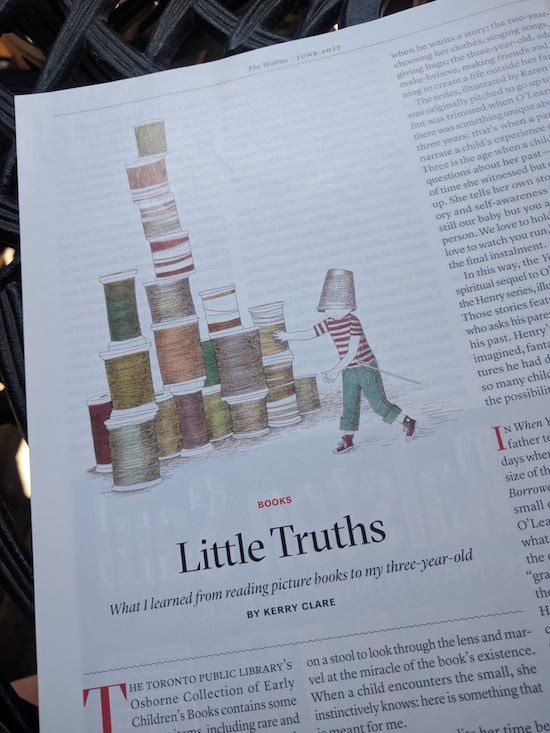
May 29, 2017
Age 8
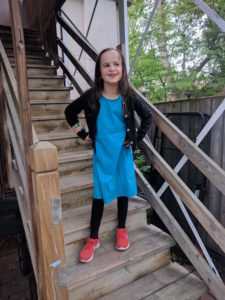 I remember being eight. I mean, I remember being younger too, but eight is the earliest age I feel a connection to: that was me then. I did a public speech on sexist stereotypes and started being praised for my story-making prowess when I was eight. I decided I wanted to be a writer when I was eight, and now I am a writer. It was a very big year. Ramona Quimby knew as much. (A joke on the back of one of Harriet’s magazines: What did the zero say to the eight? Nice belt!)
I remember being eight. I mean, I remember being younger too, but eight is the earliest age I feel a connection to: that was me then. I did a public speech on sexist stereotypes and started being praised for my story-making prowess when I was eight. I decided I wanted to be a writer when I was eight, and now I am a writer. It was a very big year. Ramona Quimby knew as much. (A joke on the back of one of Harriet’s magazines: What did the zero say to the eight? Nice belt!)
And now Harriet is eight. How extraordinary is that? That the tiny little bundle I held in my arms so long ago, that nut brown baby with that perfect little button face, a simply beautiful infant (and everyone said so) has burst forth into this girl, this small woman, all arms and legs and laugh and gappy teeth. Irrepressible. Where did she come from? Where is she going? Whoever would dare to stand in her way?
She reads, all the time now. I think it was as recently as Christmas that I’d have to promise her there were pictures in a novel before she’d consent to read it, but now she reads everything—although she’d pick up the graphic novels or Archie comics first. They’re her go-to. Her books are piled all over her house, beside my book piles, and the other book piles. She is at home here, although her domain is up on the top bunk, which is hers and hers alone.
She can’t decide whether to grow up to be a rock star or a scientist. She devours books on animal facts. I never dreamed that being a mother would mean suffering car journeys in which I am dispensed fact after fact about toad sex. She still really loves hedgehogs. She makes up weird song lyrics. Last week she made up a song about city life with the lyrics, “Luxury condos and deluxe mini-vans” and I became concerned that I was not imparting our values. She wrote an alternate verse about apartment buildings and public transit to placate me. She is very understanding.
She has secrets. She has stories. I used to write posts like this on her birthday in order to capture her exactly as she is before she becomes a whole new person tomorrow, but she is old enough now that she cannot be captured. She belongs to herself and I am simply observing, albeit with wonder. I made her, but she has nothing to do with me. She is her own incredible self going out into the world, and when she gets anxious I remind her: “You are smart and you are brave.” She will figure it all out. The process being the very point, of life itself.
She is funny, she is silly, she is grumpy, she is moody, she is sullen, she is kind. And she feels things, picking up on subtle points, throwaway details on the radio from five days ago. Sometimes I think we ought to turn the radio down, but no. This is the world and we’re giving it to her, and she deserves to know what she’s getting. This is the world, all of it, and it’s our job to figure out how to love it anyway.
She is tall, she is gangly, she has freckles across her nose. She wants to get her ears pierced, which seems reasonable, except I am afraid the first punch will scare her and she’ll be too terrified for the second, and then she’ll be an earring cyclops. She’s a bit of a melodramatic. She still loves us, so much, and we adore her too, and admire her, and enjoy her company. Most days. It’s mutual. She’s an incredible sister, and while Iris is a perfectly admirable person in her own right, we have Harriet to thank for a lot of her goodness. Iris has learned good things from her sister, kindness, patience, and how to love. Although Harriet is growing up enough that now Iris is the person walking around the house complaining because no one wants to play dragon witch hunter with her, which is the role in our household Harriet alone used to occupy. But Harriet is off somewhere reading.
She was always herself. She is becoming herself. I am so grateful that she’s in the world, and grateful to the world for bringing her to us, and I love her. I remember how it took me a little bit of time to learn to love her, which was ridiculous now, but man oh man was it ever worth the wait.
May 26, 2017
The Gold Leaf, by Kirsten Hall and Matthew Forsythe
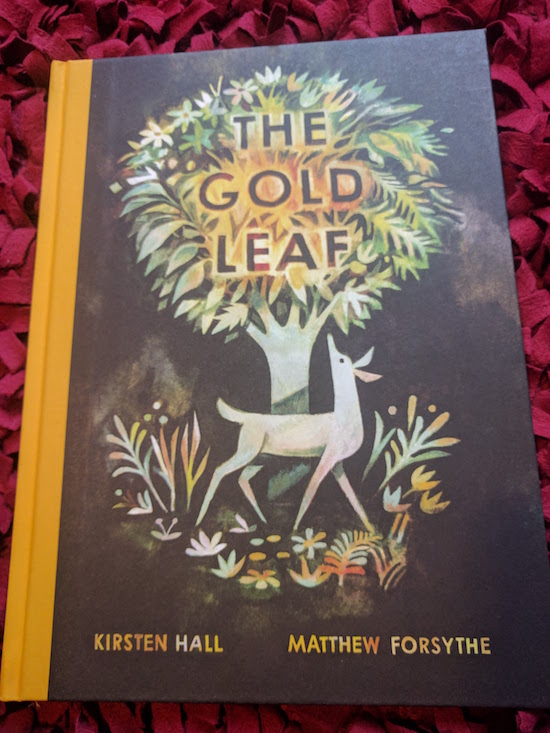
The Gold Leaf is the kind of book that you’d think at first glance was by an author/illustrator, a conceptual book in which the images are fundamental. Beautiful, lush, classical styled illustrations of a forest turning into spring.
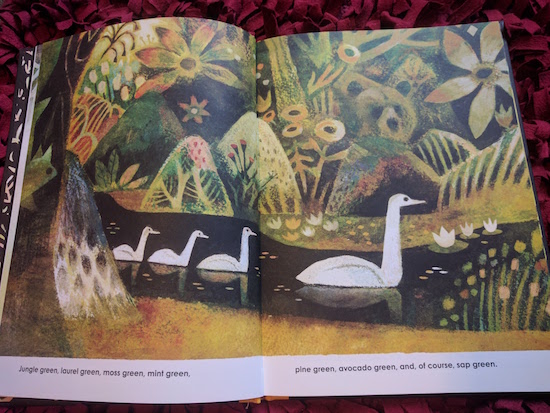
But then the words too, all the ways to describe greenness. “Jungle green, laurel green, moss green, mint green, pine green, avocado green…” I love any book that emphasizes the many different ways there are to be one thing. I also love how in this case, the splendid text is enriching the picture.
Anyway, the animals are awakening from winter slumbers and in all the newness and excitement, everyone almost misses the sight of something most unusual:
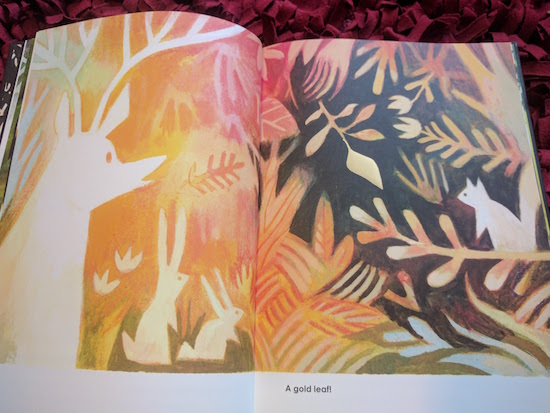

An author’s note explains the process and history of gold leaf as an art form, as well as the the author’s grandfather was responsible for the gold leafing on many famous buildings in New York City, adding another layer of texture to this beautiful story.
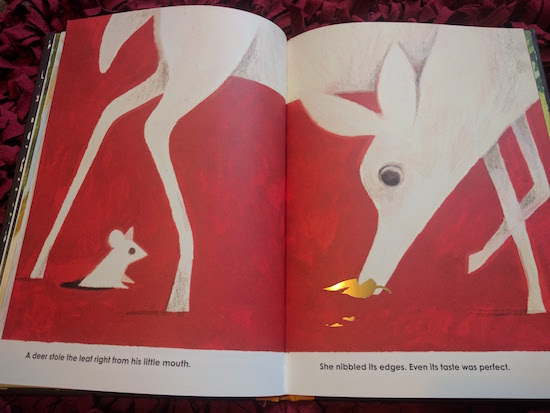
Well, obviously the gold leaf is coveted amongst the forest creatures, and one after another they snatch it, keep it, grab it and run, and the inevitable occurs—the leaf falls to pieces, scattered in the wind. And then life in the forest goes on as it should—until the following spring (with “pear green, pickle green, parakeet green…”) when the gift returns to them. A story about second chances, gifts and mercy, maybe, and community, precious resources, and how much richer we are when we take care of each other.
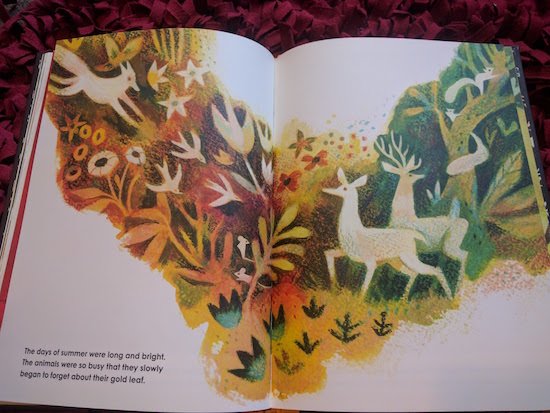
The book, in its exceptional design and quiet story, reminds me of Coralie Bickford-Smith’s The Fox and the Star, which we loved, and also a little bit of Kyo Maclean’s beautiful new book, The Fog, with its subtle environmental message and open-endedness (and also a warbler). And yet its utterly itself as well, and we absolutely love it.
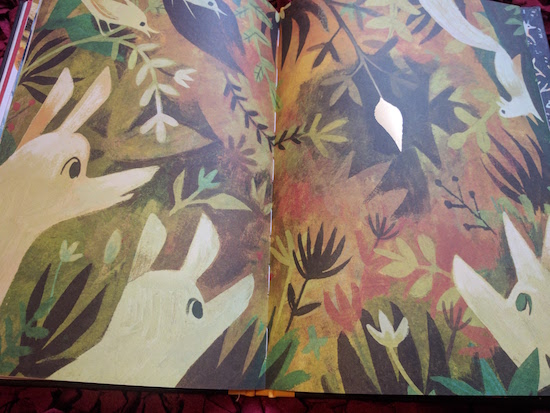
May 25, 2017
The Slip, by Mark Sampson
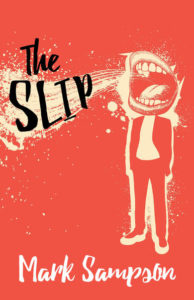 It was a very interesting moment in which to be reading Mark Sampson’s new novel, The Slip, the week after a thoughtless editorial on cultural appropriation led to an idiotic conversation on Twitter, and then the inevitable response referring to lynch-mobs and and witch hunts. In The Slip, Sampson wades into this conversation about outrage and p.c. culture, but with unfathomable thoughtfulness and nuance, and also manages to be hilarious to boot.
It was a very interesting moment in which to be reading Mark Sampson’s new novel, The Slip, the week after a thoughtless editorial on cultural appropriation led to an idiotic conversation on Twitter, and then the inevitable response referring to lynch-mobs and and witch hunts. In The Slip, Sampson wades into this conversation about outrage and p.c. culture, but with unfathomable thoughtfulness and nuance, and also manages to be hilarious to boot.
But it will take a chapter or two. I have a personal gauge for a narrative voice I’m willing to tolerate, in fiction and non, and if the word “sclerotic” is in your lexicon, you’ve basically lost me. The voice of Sampson’s narrator, absent-minded professor and public intellectual Dr. Philip Sharpe, therefore, requires some patience on the part of the reader, to be willing to entertain his allusions and extensive vocabulary. To come to understand that “entertain” is the very point: this is satire and very very funny. Don’t bother getting your dictionary out, unless you really want to increase your word power—to worry about this is to get bogged down in the details, and I’d advise you instead to lose yourself to the book’s flow.
The situation is this: left-wing intellectual Philip Sharpe says something horrifying in a televised debate with a right-wing pundit who is a woman, and I promise you you will probably gasp on page 37 just like I did. Outrage ensues, a social media furor, angry editorials, student walk-outs, etc. What caused Philip to say what he did? Well, his mind was caught up in domestic troubles, and there’s the fact that try as he might he cannot secure his poppy—the book is set in early November and to appear poppy-less on television is a national crime. And so he’s not completely in control of his faculties as his opponent tries to get the better of him. In fact, Philip is so far out of the loop that he doesn’t actually register the remark that he made that’s upset so many people. “I can be a bit oblivious,” he says at one point in the text, and I’ll say. So he cannot begin to fathom why people are so worked up about an inarticulate point he made about Canadian corporate executives in which he’d so shamefully denied the categorical imperative.
Of course, Philip Sharpe can’t fathom a lot of things—social media, for one. Or cell-phones. Or his wife’s state of mind lately, and why she refuses to get a job beyond writing a parenting column bimonthly, and what her lack of contribution means for their enormous mortgage. All of which gives Sampson a lot of space to traverse the misunderstanding between Sharpe’s supposed slip and what he’s actually said. He’s accustomed to being a bit out of sync with the world, although he’s a bit curious about why the outcry is so disproportionate. And to give us a bit of background into his situation and his character, Philip delves into his history between chapters concerned with the immediate scandal. His unconventional childhood, his time at Oxford, his first serious relationship, his years of success in academia, and his unexpected marriage in his early 40s, when he finds himself a stepfather.
The chapters about parenthood are wonderful. “When a child refuses to sleep, it can make your evening feel like it’s trapped inside a very bad prose poem—all jarring transitions and fragmented narrative arcs.” This chapter with the bad bedtime ends with Philip already at the end of his tether, looking at his daughter and asking himself a very philosophical question: “Remind me again, my love—why are you even here?” Which launches into a chapter about his daughter’s birth, a home birth through which his wife insisted on The Indigo Girls’ “Closer to Fine” playing over and over again. The chapter had me in hysterics and ended on the most excellent note, portraying the awful and ecstatic tones of parenthood.
Anyway, it all goes like this, swiftly, swiftly—I read the book in two days. Soon the anti-feminists are reaching out to support Philip, and his stepdaughter is receiving nasty notes on Facebook, and even the barkeep in Philip’s local isn’t bothering to talk to him. And then finally, the revelation. What he said isn’t what he thinks he’s said, and Philip is horrified at what he’s done, what people have been thinking. Which allows the narrative to turn into something beyond satire, into more of a critique as well on outrage culture, and outrage-at-outrage culture. In a way, The Slip is an inverted version of Zoe Whittall’s The Best Kind of People, with its take on rape culture, feminism and MRAs, and the two books are very interesting companions, making similar points in very different ways.
I loved The Slip. Mark Sampson is my friend, and I read his book intending to avoid full-disclosuring by not writing about it at all, but I liked it so much and have so much to say about it that I really couldn’t help it.
May 23, 2017
Mitzi Bytes in the World
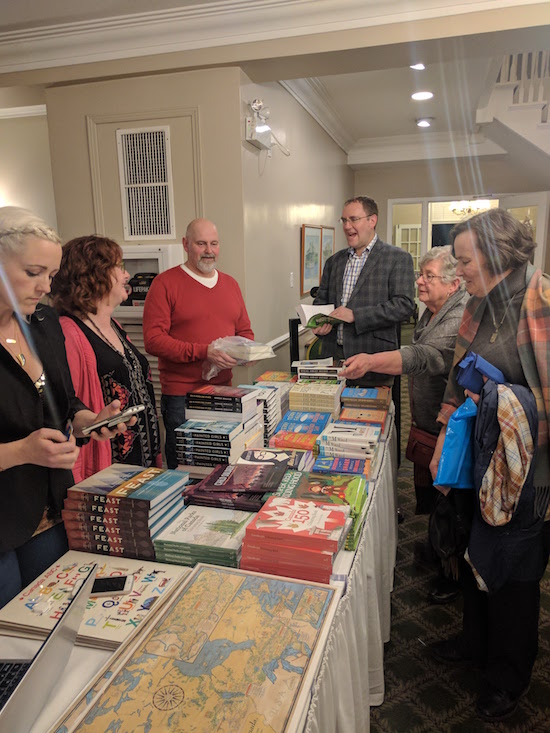
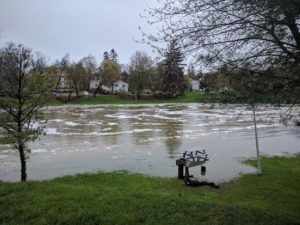 After a flurry of busy-ness, I’m playing a bit of catch-up with news of Mitzi Bytes in the world. Earlier this month I had the great pleasure of travelling to Gananoque to take part in the 1000 Islands Writers Festival. This was the weekend it rained every day following the week during which it rained every day, and by Saturday the rivers had burst their banks and there were fewer islands than a thousand. But even flooding didn’t dampen the spirit of the festival. I had a very good time, staying at the historic Gananoque Inn and rooming right next door to Lindy Mechefske, who I’ve been online friends with for awhile and whose Sir John’s Table I loved. On Saturday morning, Lindy and I did a panel about writing, blogging and social media, which was terrific fun and illuminating for all of us, and then I taught a blogging workshop following that—and got to meet Emily Prout, of the very cool and empowering blog, Arrow It Forward. My other event was later that day, a conversation about motherhood at the Gananoque Library with a small circle of women ranging from new moms to a great-grandmother—and it was wonderful. What a delight to take part in a discussion, one that really happened too, and to get to know other people and learn new things about the context of my book. I’ve never encountered such a group of engaged and committed readers as I did in Gananoque, and the intimate settings were lent themselves to that dynamic.
After a flurry of busy-ness, I’m playing a bit of catch-up with news of Mitzi Bytes in the world. Earlier this month I had the great pleasure of travelling to Gananoque to take part in the 1000 Islands Writers Festival. This was the weekend it rained every day following the week during which it rained every day, and by Saturday the rivers had burst their banks and there were fewer islands than a thousand. But even flooding didn’t dampen the spirit of the festival. I had a very good time, staying at the historic Gananoque Inn and rooming right next door to Lindy Mechefske, who I’ve been online friends with for awhile and whose Sir John’s Table I loved. On Saturday morning, Lindy and I did a panel about writing, blogging and social media, which was terrific fun and illuminating for all of us, and then I taught a blogging workshop following that—and got to meet Emily Prout, of the very cool and empowering blog, Arrow It Forward. My other event was later that day, a conversation about motherhood at the Gananoque Library with a small circle of women ranging from new moms to a great-grandmother—and it was wonderful. What a delight to take part in a discussion, one that really happened too, and to get to know other people and learn new things about the context of my book. I’ve never encountered such a group of engaged and committed readers as I did in Gananoque, and the intimate settings were lent themselves to that dynamic.
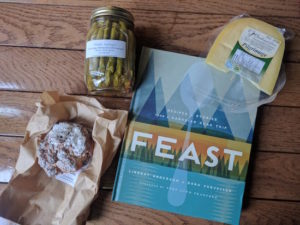 I’d gone to see novelist Terry Fallis and spoken word artist PrufRock Shadowrunner the first evening of the festival, and finished the Saturday with a wonderful and delicious event with Lindy and Lindsay Anderson and Dana VanVeller of the cookbook Feast: An Edible Roadtrip. It was also very nice to see Cathy Marie Buchanan and Claudia Davila again, and meet kids authors Paul Covello and Jess Keating (whose Pink Is For Blobflish went down very well at our house…). On Sunday morning all the authors had a delicious breakfast at the golf club on the banks of the river (which were nearer than they should have been) with a packed house of readers who’d enjoyed the weekend as much as we had. I was also glad to get a chance to check out Beggar’s Banquet Books before I headed out of town—an excellent new and used bookstore with Mitzi Bytes in stock.
I’d gone to see novelist Terry Fallis and spoken word artist PrufRock Shadowrunner the first evening of the festival, and finished the Saturday with a wonderful and delicious event with Lindy and Lindsay Anderson and Dana VanVeller of the cookbook Feast: An Edible Roadtrip. It was also very nice to see Cathy Marie Buchanan and Claudia Davila again, and meet kids authors Paul Covello and Jess Keating (whose Pink Is For Blobflish went down very well at our house…). On Sunday morning all the authors had a delicious breakfast at the golf club on the banks of the river (which were nearer than they should have been) with a packed house of readers who’d enjoyed the weekend as much as we had. I was also glad to get a chance to check out Beggar’s Banquet Books before I headed out of town—an excellent new and used bookstore with Mitzi Bytes in stock.
**
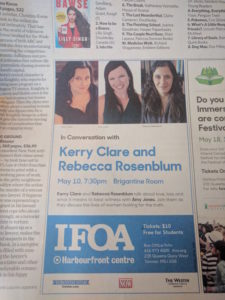 And then Wednesday night was the big finale to a very busy two months of Mitzi Bytes events—although stay tuned for other happenings throughout summer and fall. That night I had the great privilege of taking part in the IFOA Weekly Series with my very dear friend Rebecca Rosenblum, whose book So Much Love (NOMINATED FOR THE AMAZON.CA FIRST NOVEL AWARD!) came out the same day as mine. Moderated by the excellent Amy Jones and hosted by Sheniz Janmohamed, it went as well as you might expect for a conversation by two friends who have a lot of good things to say about each others’ work—which is to say, very well. Amy did a terrific job drawing connections between two novels that are very different, we all had a lot of fun, and, as Sheniz commented afterwards, we manage to broach some very timely ideas: “What does it mean to own your story? What is the responsibility that comes with telling other people’s stories?”
And then Wednesday night was the big finale to a very busy two months of Mitzi Bytes events—although stay tuned for other happenings throughout summer and fall. That night I had the great privilege of taking part in the IFOA Weekly Series with my very dear friend Rebecca Rosenblum, whose book So Much Love (NOMINATED FOR THE AMAZON.CA FIRST NOVEL AWARD!) came out the same day as mine. Moderated by the excellent Amy Jones and hosted by Sheniz Janmohamed, it went as well as you might expect for a conversation by two friends who have a lot of good things to say about each others’ work—which is to say, very well. Amy did a terrific job drawing connections between two novels that are very different, we all had a lot of fun, and, as Sheniz commented afterwards, we manage to broach some very timely ideas: “What does it mean to own your story? What is the responsibility that comes with telling other people’s stories?”
There were lots of people there, and it was such a good vibe—a spectacular close to the season of Mitzi. And I am so grateful to everybody who has supported the book so well this spring—it has meant the world to me.
**
I was also lucky to take part in two great conversations that have found their way into print. Check out “A Spy Among Us”, by Stacey Gibson at U of T Magazine, and Ann Cinzar’s interview with me at Literary Mama.
May 22, 2017
Glass Beads, by Dawn Dumont
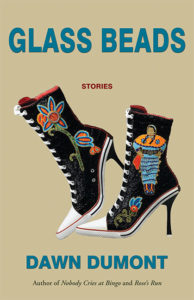 “Why is Friends on every channel?” is a question posed at the beginning of one of the inter-connected short stories in Dawn Dumont’s new book, Glass Beads, and the answer to that question is the same as the answer to another one: What makes Glass Beads so compulsively readable? A cast of compelling characters each so different and singular that their interactions create interesting conflict, plus sparkly witty dialogue. In the same way that Friends is a show you can have playing in the background, I read Glass Beads in two days. And yet—to say the book is similarly easy (the kind of thing you can have playing in the background) is to undermine its substance, the darkness at its margins and core. But still: the darkness is not the whole point.
“Why is Friends on every channel?” is a question posed at the beginning of one of the inter-connected short stories in Dawn Dumont’s new book, Glass Beads, and the answer to that question is the same as the answer to another one: What makes Glass Beads so compulsively readable? A cast of compelling characters each so different and singular that their interactions create interesting conflict, plus sparkly witty dialogue. In the same way that Friends is a show you can have playing in the background, I read Glass Beads in two days. And yet—to say the book is similarly easy (the kind of thing you can have playing in the background) is to undermine its substance, the darkness at its margins and core. But still: the darkness is not the whole point.
Last week on twitter, Tracey Lindberg asked a kind of rhetorical question about the possibility of Indigenous beach reads. A rhetorical question because her point is that Indigenous literature is pushed to be issues-based and doesn’t get to be fun, light and joyful in the way that other literatures do. And the closest answer I have to the idea of an Indigenous beach read is Dawn Dumont’s work, including Glass Beads, which follows Rose’s Run (a book I loved) and Nobody Cries at Bingo. Her work is as smart and funny as you’d expect from a writer whose background includes law and standup comedy, never shying away from big issues and politics (in Rose’s Run, a demon draws on the strength of women to seek justice for innumerable wrongs committed against them by men; in the context of missing and murdered Indigenous women, this is no small statement) but written with a decidedly commercial bent.
Billed as a collection of connected short stories, Glass Beads actually works astoundingly well as a novel, told from four perspectives between 1993 and 2008. Friends Nellie and Julie whose ties go back to childhood on their reserve, although they’re very different. Nellie is stubborn, smart and determined to become a lawyer, whereas Julie is unsettled, rattled by early loss and childhood traumas and given a lot of latitude because of her beauty. Nellie is in love with Everett, who is gorgeous but a bit dumb, and unwilling to give her the commitment she longs for. Abandoned by his parents, Everett carries his own baggage. Rounding out their foursome is Taz, who knows Nellie through the Native Students Council at their university and Everett because Taz buys drugs from his roommate. Taz and Julie become an unlikely couple, on-again and off-again as Everett and Nellie are.
The ties between the four of them deeply wound, binding, ever changing, time and experience bringing them together and apart. Nellie achieves her career goals, but find that there is still much to yearn for. Julie drifts, loses her way, and comes home again, at one point become incarcerated for her part in a fight, and is forced to partake in a substance abuse program even through she doesn’t have a substance abuse problem—but the carpentry program was full and that’s what happens when you’re a human being instead of a statistic. Taz moves from work with the provincial government to become Grand Chief of the Provincial Council of First Nations, with Nellie supporting him professionally. And Everett finally begins to the connect with the culture that was stolen from him when he lost his father, his ties to Nellie cemented when she gets pregnant with their child.
That we can read a book from four different perspectives and still not know everything, and that Dumont can create tension and shocking moments with that space beyond the limits of what we know about these characters is a testament to Glass Beads‘ craftsmanship, and why I consider it a novel more than stories—the book as a whole is deftly plotted. Its characters change and grow, harden yet remain vulnerable, get together and fall apart, and pick up the pieces again, and here we are witnessing all of it. We feel like we know them. Like a certain 1990s’ sitcom, but infinitely more interesting.





